Intellectual Disability Employment Statistics | Update 2024
Intellectual disability, also known as Intellectual Developmental Disorder or just ID, is a condition characterized by limitations in intellectual functioning and adaptive behavior, affecting a person’s ability to learn, reason, and communicate. People with intellectual disabilities often face many challenges in life, including education, healthcare, and limited employment opportunities.
As we already know, employment is essential for everyone, more so for people with intellectual disabilities as it provides them with financial independence, a sense of purpose, and a better quality of life. It also has benefits for the rest of society as it helps to break down stereotypes and promote inclusion and opportunities for everyone.
Therefore, in this article, we will explore the current state of employment for people with intellectual disabilities in the United States, the good and bad, and some resources and tips to have better conditions in the future.
In this intellectual disability employment statistic roundup, you’ll learn:
–General Overview of Intellectual Disability Statistics
–Employment Demographics on Intellectual Disabilities
–Where do people with intellectual disabilities work at?
–Intellectual Disabilities Statistics Per State
–Barriers to Employment for Individuals with Intellectual Disability
–Efforts to Promote Employment
Is your company offering suitable jobs for people with disabilities? As an employer, you can publish your job offers on MyDisabilityJobs and reach thousands of qualified candidates.
- Size Population: about 6.5 million people in the United States have an intellectual disability.
- Employment Rate: Only 19,1% of people with intellectual disabilities are employed in the United States, compared to the employment rate of people without disabilities, which is 61.8%.
- Labor Force: Less than one out of every two working-age adults with ID is in the labor force, and 28% have never held a job.
- Unemployment Rate: is 17%, which is more than double the unemployment rate for people with other disabilities and almost 4 times the unemployment rate for the general population.
- Gender Gap: Women with intellectual disabilities face bigger challenges in employment than men and when they are employed, they earn lower wages.
- Median Wage: the median annual earnings for people with intellectual disabilities were $11,400, compared to $31,100 for people without disabilities.
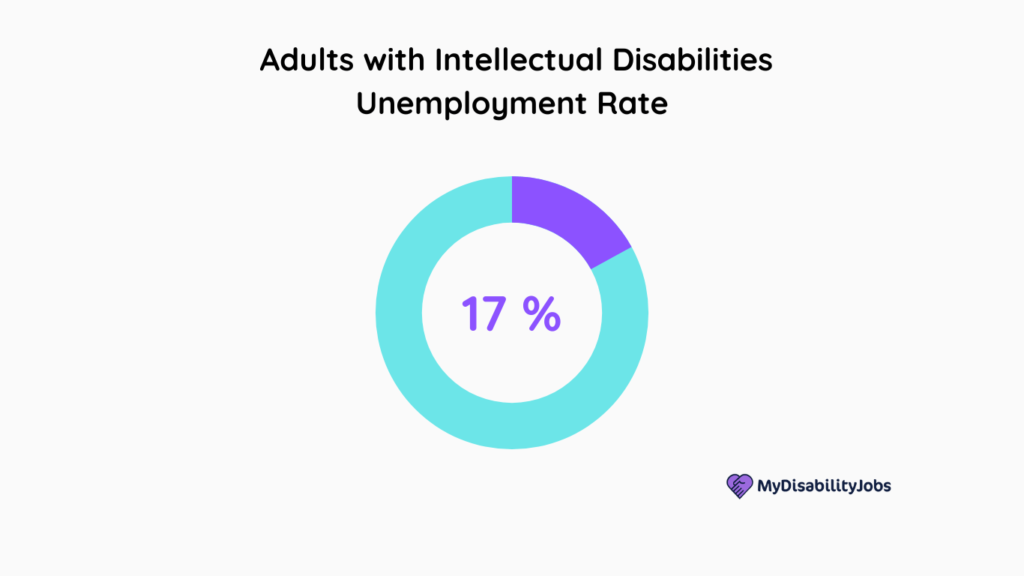
Source: Centers for Disease Control and Prevention (CDC), Bureau of Labor Statistics, SpecialOlympics.org, Disabilitystatistics.org, National Library of Medicine, Academia
General Overview of Intellectual Disability Statistics
- According to the Centers for Disease Control and Prevention (CDC), about 6.5 million people in the United States have an intellectual disability. These populations face many challenges in life, and one of the most significant is employment, having a very high unemployment rate being often underemployed or working in low-wage jobs.
- While the Bureau of Labor Statistics (BLS), reports that the employment rate for people with a disability was 17.9% in the last years, compared to 61.8% for people without disabilities, the employment rate for people with intellectual disabilities is shockingly lower.
- The Special Olympics organization found that less than one out of every two working-age adults with ID is in the labor force (meaning currently employed or searching for work). And 28% of working-age adults with ID have never held a job.
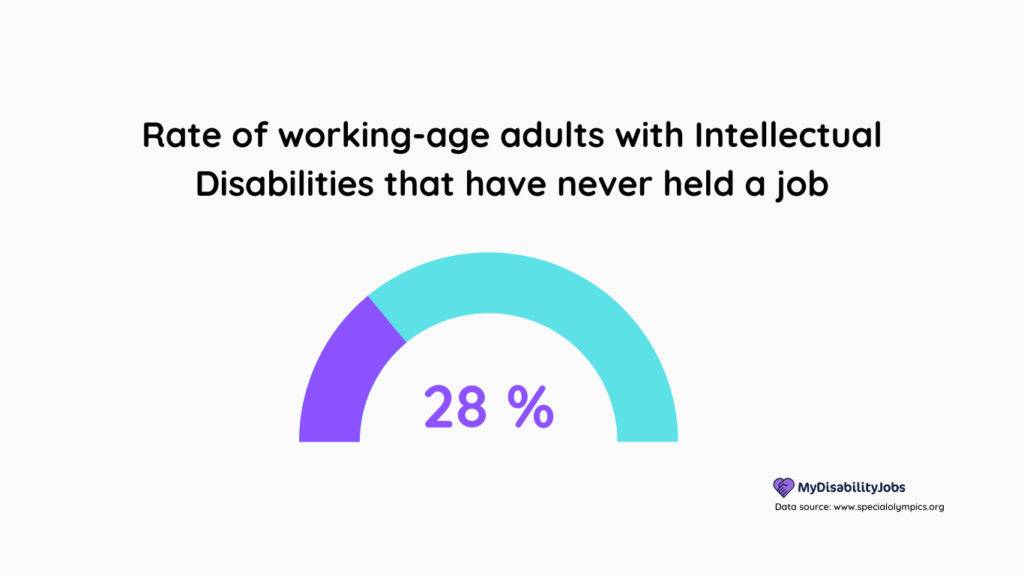
- According to a 2018 report by the Institute on Disability at the University of New Hampshire, only 19.1% of people with intellectual disabilities were employed in the United States. This is a significantly lower rate than people with other disabilities, and also lower than the general population. The employment rate for people with intellectual disabilities has remained relatively stagnant for the past few years.
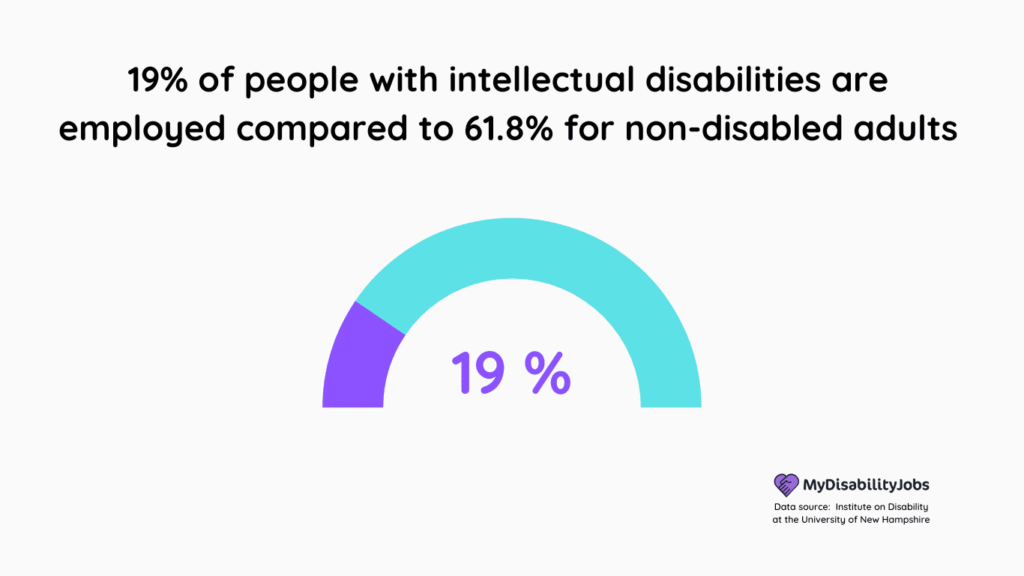
- The unemployment rate for people with intellectual disabilities is even more staggering. The unemployment rate for people with disabilities in the United States is 8%, but for people with intellectual disabilities, the rate is 17%. This is more than double the unemployment rate for people with other disabilities and almost four times the unemployment rate for the general population.
- During the COVID-19 pandemic, people with an intellectual disability experienced a greater impact on their employment than the general population, with many losing their jobs or experiencing reduced hours. This highlights the need for increased support and resources for people with intellectual disabilities during times of economic instability.
- People with intellectual disabilities also face challenges in accessing health insurance and medical leave. According to a 2017 report by the National Council on Disability, people with intellectual disabilities were more likely to be uninsured than people without disabilities. And 16.6% of people with intellectual disabilities are currently uninsured, compared to 7.7% of people without disabilities.
- Despite the unemployment figures, those who have access to employment may have moderate stability. Around 62% of adults with ID employed in a competitive setting have been at their current job for 3 years or more. While 81% of adults with ID employed in a sheltered setting have been at their current job for 3 years or more.
- Additionally, based on the American Community Survey, in 2018, the median annual earnings for people with intellectual disabilities were $11,400, compared to $31,100 for people without disabilities.
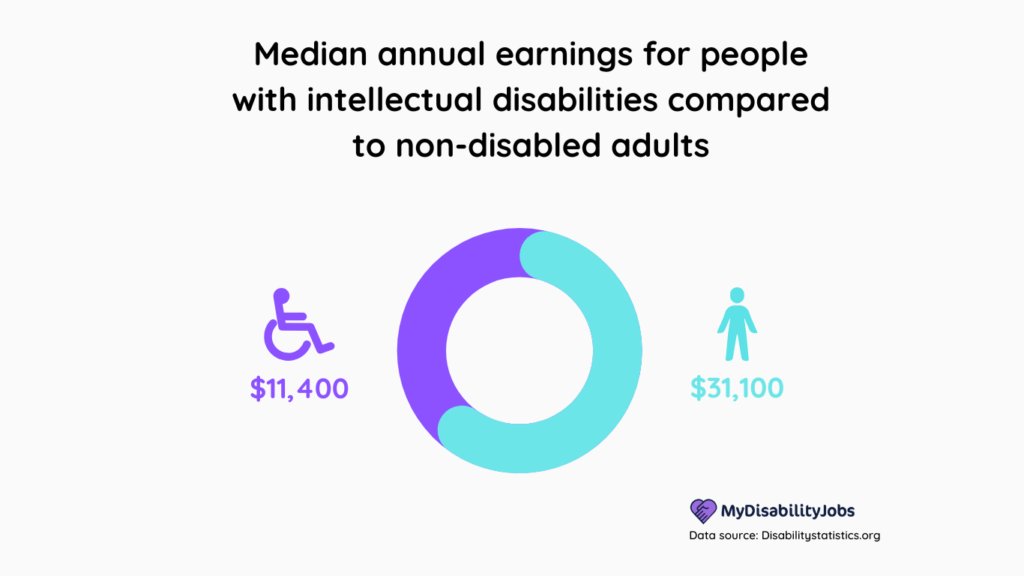
Source: Centers for Disease Control and Prevention (CDC), Bureau of Labor Statistics, SpecialOlympics.org, Disabilitystatistics.org.
Employment Demographics on Intellectual Disabilities
The employment statistics for people with intellectual disabilities vary enormously depending on demographics such as gender, age, and ethnicity.
- Among people with intellectual disabilities, women face bigger challenges in employment than men, and when they are employed, they earned lower wages.
- Older adults with intellectual disabilities also face difficulties in employment, with a lower employment rate than younger adults. In 2018, only 13.5% of people with ID aged 45 and older were employed, compared to 25.4% of people with intellectual disabilities aged 18 to 44.
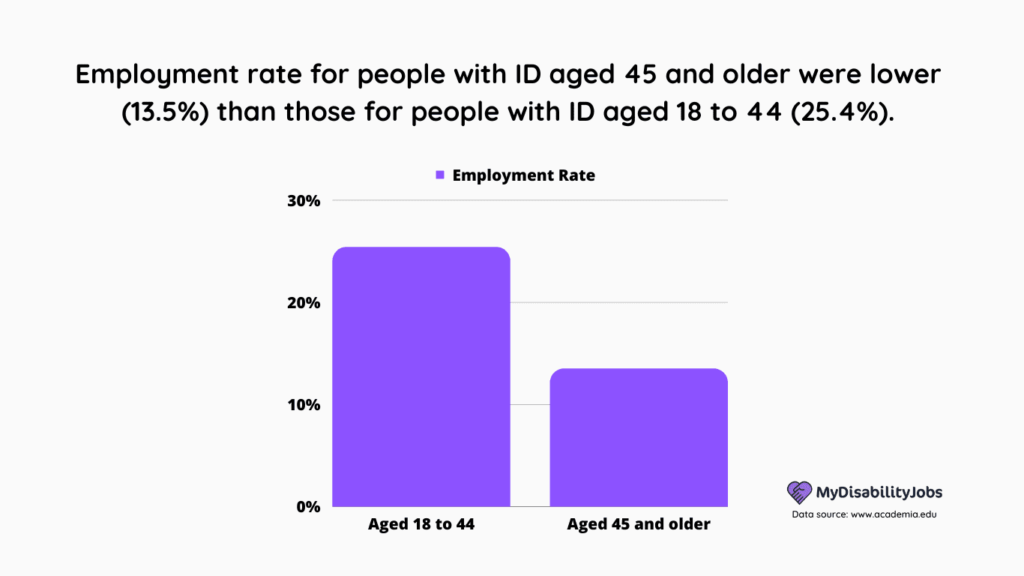
- Studies show that young adults with intellectual disabilities can have more benefits from early intervention and transition services.
Source: National Library of Medicine, Academia
Where do people with intellectual disabilities work at?
People with intellectual disabilities are employed across a wide range of industries, although some industries employ more people with intellectual disabilities than others.
- According to a 2017 report by the National Core Indicators, people with intellectual disabilities were more likely to be employed in service jobs with an estimate of 26.8%.
- The percentage of adults with ID in production jobs was 12.3%.
- In the professional jobs area, the amount of people with ID is significantly less with a share of only 4.4%.
- Some of the most common industries for people with intellectual disabilities include food service, janitorial services, and retail.
- However, there are many other industries that could benefit from hiring people with intellectual disabilities, including healthcare, manufacturing, and technology.
Source: National Core Indicators,
Intellectual Disabilities Statistics Per State
The employment statistics for people with intellectual disabilities also vary significantly across different states in the US.
- The states with the highest employment rates for people with intellectual disabilities in the US are Vermont with 42.7% of the workers, Oregon with 40.8%, and Minnesota with 37.3%.
- The states with the lowest employment rates are Arkansas with only 10.8%, Alabama with 11.2%, and Mississippi with 11.5%.
These disparities highlight the need for increased localized efforts to promote employment opportunities for people with intellectual disabilities, especially in states with lower employment rates for them.
Barriers to Employment for Individuals with Intellectual Disability
There are several barriers that people with ID face when it comes to finding and maintaining employment. These include:
Limited education and training
Unfortunately, people with ID often have limited access to education and training opportunities, which can make it difficult for them to acquire the necessary skills and qualifications for employment.
Lack of job opportunities
Many employers are hesitant to hire talent with intellectual disabilities, as they may not be aware of their abilities or how to accommodate their needs.
Stigma and discrimination
Stigma and discrimination: People with ID face stigma and discrimination from employers, colleagues, and society in general, which can make it difficult for them to secure and maintain employment.
Inadequate support services
As workers with intellectual disabilities require additional support and accommodations to succeed in the workplace they rely on services that are often underfunded or not available, making it difficult for them to access the tools to succeed in their search.
Benefits to employing people with intellectual disabilities
Workers with this condition can be reliable, dedicated, and hardworking employees who take pride in their work. They can also bring unique perspectives and skills to the workplace. Additionally, hiring people with intellectual disabilities can be good for business. Many companies have found that hiring people with disabilities improves employee morale and customer satisfaction.
Efforts to Promote Employment
There are several initiatives aimed at increasing employment opportunities for people with intellectual disabilities in the United States. Let’s review some of them:
Workforce Innovation and Opportunity Act (WIOA)
This is a federal program that provides funding for job training and support services for people with disabilities, including intellectual disabilities. The goal of the program is to increase employment rates for the target people by providing different tools in their processes of employment.
Project SEARCH
A high school transition program that provides on-the-job training and employment opportunities for young adults with intellectual disability. Project SEARCH partners with businesses and organizations to provide internships and job training for participants, with the goal of helping them gain competitive employment.
The Work Opportunity Tax Credit (WOTC)
A federal government tax incentive to businesses that hire people with intellectual disabilities. This effort looks forward to offsetting the costs of providing accommodations and support services.
There are also many advocacy organizations working to increase awareness about intellectual disability and promote employment opportunities for people with this condition. The National Down Syndrome Society, The Arc, the Special Olympics, and Best Buddies are just a few examples of organizations that are working to increase employment opportunities and improve the quality of life for people with intellectual disabilities.
Despite these efforts, there is still a long way to go in promoting employment opportunities for people with intellectual disability. One major challenge is shifting societal attitudes toward people with intellectual disability, recognizing their potential and contributions in the workplace. Employers must also be provided with resources and support to hire and accommodate people with intellectual disability, including diversity recruiting strategies, DEI trainings, developing accessibility in the workplace and assistive technology.
Is your company offering jobs for people with disabilities? As an employer, you can publish your job offers on MyDisabilityJobs and reach thousands of qualified candidates.
Conclusion
The employment statistics for people with intellectual disabilities paint the picture of the significant challenges they face in accessing employment opportunities. Despite the fact that many individuals with an intellectual disability possess valuable skills and talents that can contribute to the workforce, they are often overlooked due to societal stigma and a lack of understanding about their capabilities. This is reflected in the low employment and high unemployment rates for adults with intellectual disabilities, as well as their lower median annual earnings compared to those without disabilities. However, there is hope on the horizon as more efforts are being made to promote employment and increase awareness about intellectual disability in the workplace.
One important strategy is to increase awareness and understanding of intellectual disability among employers, co-workers, and the general public. By educating employers about the unique abilities and strengths of people with intellectual disabilities, we can challenge misconceptions and foster a more inclusive work environment. Additionally, providing training and resources for employers on disability etiquette, workplace accommodations, and how to support employees with an intellectual disability can help create a more welcoming and supportive workplace culture.
By investing in education and vocational training programs, providing training and resources for employers, and challenging misconceptions about intellectual disability, we can work towards a more inclusive and equitable workforce for all. By embracing the diverse skills and talents of all individuals, including those with intellectual disabilities, we can create a stronger, more vibrant, and more successful society.
FAQ
The unemployment rate for people with intellectual disabilities in the United States is 17%
Related articles:
Diversity in the Tech Industry: Statistics
Costs of Bullying and Harassment in the Workplace
Workplace Bullying Statistics Research & Facts
Statistics of Diversity in the Workplace
Mental Health and Employment Statistics
Disability and Depression Statistics
Disability and Employment Discrimination Statistics
Bipolar Disorder and Employment Statistics


Comments are closed